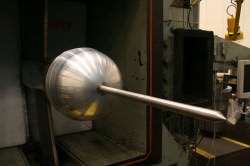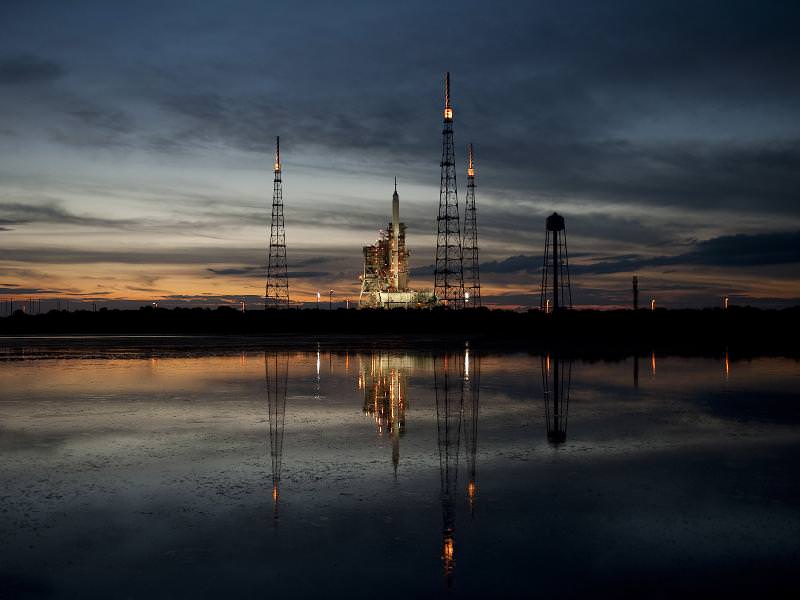[/caption]
The test flight for the Ares I-X rocket was scrubbed on Tuesday after a roller coaster of repeated delays which included weather, a stuck cover on a probe, a cargo ship straying into the launch hazard zone, weather, and weather. “We had some opportunities, but just couldn’t get there,” launch test director Ed Mango said to the team. “Weather didn’t cooperate.” The biggest issue with weather was the launch commit criteria of avoiding possible static discharge called “triboelectrification” created by the outer coating of the rocket rubbing against cloud vapor or precipitation that is colder than -10 degrees C (14 deg. F). This static electricity could disrupt the transmission of flight test data from the rocket, and getting data is one of the main desired outcomes for the test flight.
Another 4-hour launch window opens at 8 am EDT (1200 GMT) on Wednesday.

On Tuesday, when the weather improved enough to remove the 5-hole probe cover, then came a problem with removing it. This difficulty was not anticipated.
“After hundreds of tests with the probe, that’s the first time we’ve seen that failure mode,” said NASA engineer Jon Cowart on NASA TV. On Twitter, a NASA engineer shared that they gave the pad crew the recommendation to pull the lanyard attached to the cover “as hard as you can.” It worked.
Then came a cargo ship that entered the hazard area in offshore waters. The ship was notified and it turned around quickly.
But by that time the weather had deteriorated. Good on their word that they could quickly restart the countdown clock, the launch team tried several times to coordinate a hole in the clouds with acceptable (less than 20 knots) ground and upper level winds. It was a roller coaster of “go” and “no-go,” but ultimately the weather cards never fell into the fight configuration to allow the launch to take place.
Tomorrow the weather is better but not great. The chance of unacceptable conditions drops to 40% no go for Wednesday, as opposed to 60% no go today. Forecasters predict somewhat quieter winds at ground level, upper level winds are expected to be lighter and clouds will be decreasing, with more breaks in the clouds.
The test flight will last six minutes from liftoff to splashdown, with the Ares I-X reaching a maximum altitude of 46,000 m (153,000 feet) and a top velocity more than 4.7 times the speed of sound.
And if you are still wondering about triboelectrification, it basically is static electricity such as what you might encounter when you rub a balloon on your shirt, or rub your feet on a dry carpet or brush up against a cat and then touch a metal surface. Zap!
In the case of Ares I-X, flying through high-level clouds can generate “P-static” (P for precipitation), which can create a corona of static around the rocket that interferes with radio signals sent by or to the rocket. This would create problems when the rocket tries to transmit data down to the ground or if the Range Safety Officer at Cape Canaveral Air Force Station needed to send a signal to the flight termination system (a.k.a. blow up the rocket because of a big problem.)


I don’t understand the necessity of ‘launch windows’ for a suborbital flight.
Anyone does?
Manu- In this case, it’s more about the time allotted or set aside to do the launch. The area has to be cleared of ships and airplanes, and that needs to be arranged ahead of time and then enforced. Then there’s the issue of not making the launch team, pad team, and mission control guys sit there the whole day trying to get it launched. They choose a timeframe, and stay within it.
“with the Ares I-X reaching a maximum altitude of 46,000 km”
46 km?
Anyway, if was friggin annoying. I stayed up to watch this, and at one stage before I gave up the clock was stopped at 2m39s. Frustrating! I’ll probably be up again tonight though…
I like the old no log in policy and the people that it was to fix have left with there weard physics.
SO.
The universe today is the coolest thing in the knowen universe and in the process of shooting off of unmanned,single stage solid fuel booster rocket in an all weather, in day or night, in all water enviroment, after perparing for years and then waiting for weeks for a couple of minutes notice.. maybe 2:00 minutes or something, THEN a ship comes somewhere down range/ doubt they could get the internet plus low tier flag/ SO you stop the shoot can’t . Why dont you shoot more I always want to? whats this data black out? couldnt the onboard stuff be recovered hold it? Burt Rutan can land this stuff on wings. Hell I hope the pilot can surf the internet throught the filght.. After you get used to the the view the shuttle cock part could get boring.
If you need anyone to through switches in a STS call me because flying a 737 into LEO is the coolest until you can get a 747 to LEO which looks like the big Ares cargo thing can do. People need to land lake humming birds to be safe all the time, but I think landing a brick with all I want in it anywhere any time i want….which is mostly craft and people at an airport is the best way, who always wants to splash down next to a flat top? or land on your BACK on to a desert all weak and need a chopper flight out to an airport then to a location? They have time to figure out what goes on the top…. I think some thing like a shuttle cock space shuttle lifting body reuse. Save parashutes for test pilots.
Keep looking up
Nancy: thanks!
tripleclean: whaddya been smokin, dude?
@Manu:
It’s not so much all the Qualudes tripleclean ingested, it’s all the cough syrup. I’m hoping English is not his native language….